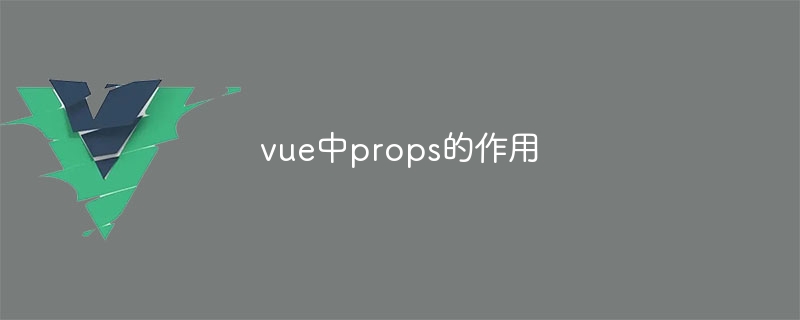The role of props in vue
The role of props in Vue.js is to pass data, isolate data, improve reusability, and perform type checking. Steps: 1. The child component declares a prop array or object; 2. The parent component uses v-bind to bind data to the child component prop.

The role of props in Vue.js
props (full name properties) is a type of Vue.js Special properties used to pass data between parent and child components. Its main functions are as follows:
1. Data transfer:
props allows parent components to pass data to child components, thereby achieving one-way binding of data.
2. Data isolation:
Each sub-component has independent props and is isolated from the props in other sub-components to avoid data pollution.
3. Improve reusability:
Subcomponents can receive different data through props, thereby improving reusability. The same subcomponent can be used in different scenarios, just modify the incoming props.
4. Type checking:
props can specify the data type to perform type checking at compile time and improve the robustness of the code.
Steps to use props:
-
Subcomponent:In subcomponent, use
propsarray or Object to declare the received props. -
Parent component: In the parent component, use the
v-binddirective to bind data to the child component's prop.
Example:
Child component:
<code><script>
export default {
props: ['message']
}
</script>
<template>
<p>{{ message }}</p>
</template></code>Parent component:
<code><template>
<my-component v-bind:message="greeting" />
</template>
<script>
export default {
data() {
return {
greeting: 'Hello!'
}
}
}
</script></code>In this case, the parent The component passes greeting data to the message prop of the subcomponent through the :message directive, and the subcomponent will render the received message.
The above is the detailed content of The role of props in vue. For more information, please follow other related articles on the PHP Chinese website!

Hot AI Tools

Undresser.AI Undress
AI-powered app for creating realistic nude photos

AI Clothes Remover
Online AI tool for removing clothes from photos.

Undress AI Tool
Undress images for free

Clothoff.io
AI clothes remover

AI Hentai Generator
Generate AI Hentai for free.

Hot Article

Hot Tools

Notepad++7.3.1
Easy-to-use and free code editor

SublimeText3 Chinese version
Chinese version, very easy to use

Zend Studio 13.0.1
Powerful PHP integrated development environment

Dreamweaver CS6
Visual web development tools

SublimeText3 Mac version
God-level code editing software (SublimeText3)

Hot Topics
 How to use map function in vue
May 09, 2024 pm 06:54 PM
How to use map function in vue
May 09, 2024 pm 06:54 PM
The Vue.js map function is a built-in higher-order function that creates a new array where each element is the transformed result of each element in the original array. The syntax is map(callbackFn), where callbackFn receives each element in the array as the first argument, optionally the index as the second argument, and returns a value. The map function does not change the original array.
 How to disable the change event in vue
May 09, 2024 pm 07:21 PM
How to disable the change event in vue
May 09, 2024 pm 07:21 PM
In Vue, the change event can be disabled in the following five ways: use the .disabled modifier to set the disabled element attribute using the v-on directive and preventDefault using the methods attribute and disableChange using the v-bind directive and :disabled
 Adaptation of Java framework and front-end Vue framework
Jun 01, 2024 pm 09:55 PM
Adaptation of Java framework and front-end Vue framework
Jun 01, 2024 pm 09:55 PM
The Java framework and Vue front-end adaptation implement communication through the middle layer (such as SpringBoot), and convert the back-end API into a JSON format that Vue can recognize. Adaptation methods include: using the Axios library to send requests to the backend and using the VueResource plug-in to send simplified API requests.
 What does async mean in vue
May 09, 2024 pm 07:03 PM
What does async mean in vue
May 09, 2024 pm 07:03 PM
Vue's async modifier is used to create asynchronous components or methods to achieve dynamic loading of components and execution of asynchronous operations to avoid blocking the main thread.
 The function of render function in vue
May 09, 2024 pm 07:06 PM
The function of render function in vue
May 09, 2024 pm 07:06 PM
The render function in Vue.js is responsible for converting component data into virtual DOM, which can improve performance, enable templating, and support cross-platform. Specific functions include: 1. Generating virtual DOM; 2. Improving performance; 3. Implementing templates; 4. Supporting cross-platform.
 How to use v-show in vue
May 09, 2024 pm 07:18 PM
How to use v-show in vue
May 09, 2024 pm 07:18 PM
The v-show directive is used to dynamically hide or show elements in Vue.js. Its usage is as follows: The syntax of the v-show directive: v-show="booleanExpression", booleanExpression is a Boolean expression that determines whether the element is displayed. The difference with v-if: v-show only hides/shows elements through the CSS display property, which optimizes performance; while v-if conditionally renders elements and recreates them after destruction.
 Nuxt.js: a practical guide
Oct 09, 2024 am 10:13 AM
Nuxt.js: a practical guide
Oct 09, 2024 am 10:13 AM
Nuxt is an opinionated Vue framework that makes it easier to build high-performance full-stack applications. It handles most of the complex configuration involved in routing, handling asynchronous data, middleware, and others. An opinionated director
 The role of main.js in vue
May 09, 2024 pm 06:57 PM
The role of main.js in vue
May 09, 2024 pm 06:57 PM
main.js is the entry file of the Vue.js application, used to boot and configure the application. Its main functions include: creating a Vue root instance, mounting the application configuration, routing, introducing components, storing data and status, installing plug-ins, defining life cycle hooks






